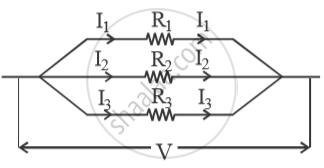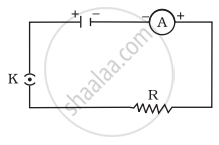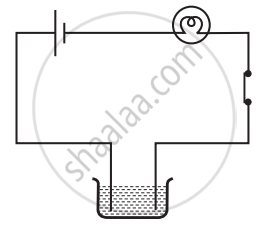Advertisements
Advertisements
Question
Three resistors of resistances R1 , R2 and R3 are connected (i) in series, and (ii) in parallel. Write expressions for the equivalent resistance of the combination in each case.
Solution
(i) Resistance are connected in series :

`therefore` V = V1 + V2 + V3
Same current will pass through all resistors
Using ohm's law ,
`therefore` IRs = IR1 + IR2 + IR3
`therefore` IRs = I (R1 + R2 + R3)
`therefore` Rs = R1 + R2 + R3
where , Rs → Equivalent resistnace in series.
(ii) Resistors connected in parallel :

Potential difference across the resistors will be same
`therefore` I = I1 + I2 +I3
Using Ohm’s law
`therefore V/R_P = V/R_1 + V/R_2 + V/R_3`
`therefore 1/R_P = 1/R_1 + 1/R_2 + 1/R_3` .
APPEARS IN
RELATED QUESTIONS
One unit of coulomb is charge of approximately ______ protons or electrons.
Match the following
| 1. | Cell | used to open or close a circuit |
| 2. | Switch | safety device used in electric circuit |
| 3. | Circuit | A complete path for the flow of an electric current |
| 4. | Miniature circuit Breaker | Reset by hand, circuit becomes complete once again |
| 5. | Fuse | A device which converts chemical energy into electrical energy |
Water can conduct electricity.
A cell, a resistor, a key and ammeter are arranged as shown in the circuit diagrams of Figure. The current recorded in the ammeter will be
 |
 |
 |
| (i) | (ii) | (iii) |
Electrical resistivity of a given metallic wire depends upon
Boojho made the circuit given in the figure and observed that the bulb did not glow. On Paheli’s suggestion, he added one more cell in the circuit. The bulb now glows. Explain.

Why is an electric fuse required in all electrical appliances?
Electricity produced on rubbing is ______.
A tiny particle that rotates around the nucleus of an atom is ______.
Choose from the options a, b, c and d given in Fig. 12.1 the figure which shows the correct direction of current.
